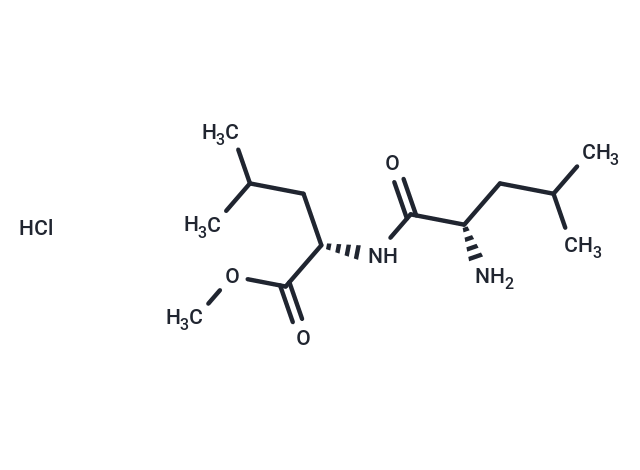Shopping Cart
- Remove All
 Your shopping cart is currently empty
Your shopping cart is currently empty

L-Leucyl-L-Leucine methyl ester hydrochloride (Leu-Leu-ome hydrochloride) is a dipeptide condensation product of L-leucine methyl ester produced by human monocytes or polymorphonuclear leukocytes. L-Leucyl-L-Leucine methyl ester hydrochloride selectively eliminates lymphocytes with cytotoxic potential and also induces lysosomal stress.

| Pack Size | Price | Availability | Quantity |
|---|---|---|---|
| 100 mg | $41 | In Stock | |
| 1 mL x 10 mM (in DMSO) | $45 | In Stock |
| Description | L-Leucyl-L-Leucine methyl ester hydrochloride (Leu-Leu-ome hydrochloride) is a dipeptide condensation product of L-leucine methyl ester produced by human monocytes or polymorphonuclear leukocytes. L-Leucyl-L-Leucine methyl ester hydrochloride selectively eliminates lymphocytes with cytotoxic potential and also induces lysosomal stress. |
| In vitro | METHODS: hSMCs cells were treated with GW 7647 (100-600 nM) for 24-96 h. DNA content was determined. RESULTS: GW 7647 treatment inhibited proliferation in a dose-dependent manner. [1] METHODS: Gastric sinus mucosa was treated with GW 7647 (50 nM) for 10 min, and the expression levels of target proteins were detected by Western Blot. RESULTS: In gastric sinus mucosa, GW 7647 stimulated PI3K phosphorylation followed by Akt (Ser473) phosphorylation, which induced NOS1 phosphorylation. [2] |
| In vivo | METHODS: To investigate the improvement of AD model and the mechanism, GW7647 (2.5 mg/kg) was administered to APP/PS1 transgenic mice daily for three months. RESULTS: GW 7647 reduced the Aβ burden and ameliorated cognitive deficits in APP/PS1 mice, and activation of PPAR-α by GW 7647 ameliorated the disruption of iron homeostasis and attenuated neuronal inflammation and lipid peroxidation in the brains of APP/PS1 mice, which may be related to the up-regulation of GPx4 transcripts mediated by the interaction between GPx4 non-coding regions and PPAR-α. [3] METHODS: To investigate the effects on hepatocarcinogenesis in mice, GW 7647 (0.01% w/w) was administered dietary to wild-type, Para-null, or PPARA-humanized mice daily for 1, 5, and 26 weeks or chronically. RESULTS: In wild-type mice, GW 7647 caused high rates of hepatic expression of known PPARα target genes, hepatomegaly, hepatic MYC expression, hepatocytotoxicity, and hepatocellular carcinoma. In contrast, these effects were largely absent in Ppara-null mice and attenuated in PPARA-humanized mice, although hepatocarcinogenesis was observed in both genotypes. [4] |
| Alias | Leu-Leu-ome hydrochloride |
| Molecular Weight | 294.81 |
| Formula | C13H27ClN2O3 |
| Cas No. | 6491-83-4 |
| Smiles | Cl.COC(=O)[C@H](CC(C)C)NC(=O)[C@@H](N)CC(C)C |
| Relative Density. | no data available |
| Storage | Powder: -20°C for 3 years | In solvent: -80°C for 1 year | Shipping with blue ice. | ||||||||||||||||||||||||||||||
| Solubility Information | 5% DMSO+95% Saline: 1.45 mg/mL (4.92 mM), In vivo: Please add the solvents sequentially, clarifying the solution as much as possible before adding the next one. Dissolve by heating and/or sonication if necessary. Working solution is recommended to be prepared and used immediately. DMSO: 27.5 mg/mL (93.28 mM), Sonication is recommended. 10% DMSO+90% Saline: 2.75 mg/mL (9.33 mM), In vivo: Please add the solvents sequentially, clarifying the solution as much as possible before adding the next one. Dissolve by heating and/or sonication if necessary. Working solution is recommended to be prepared and used immediately. | ||||||||||||||||||||||||||||||
Solution Preparation Table | |||||||||||||||||||||||||||||||
10% DMSO+90% Saline/DMSO
DMSO
| |||||||||||||||||||||||||||||||

Copyright © 2015-2025 TargetMol Chemicals Inc. All Rights Reserved.